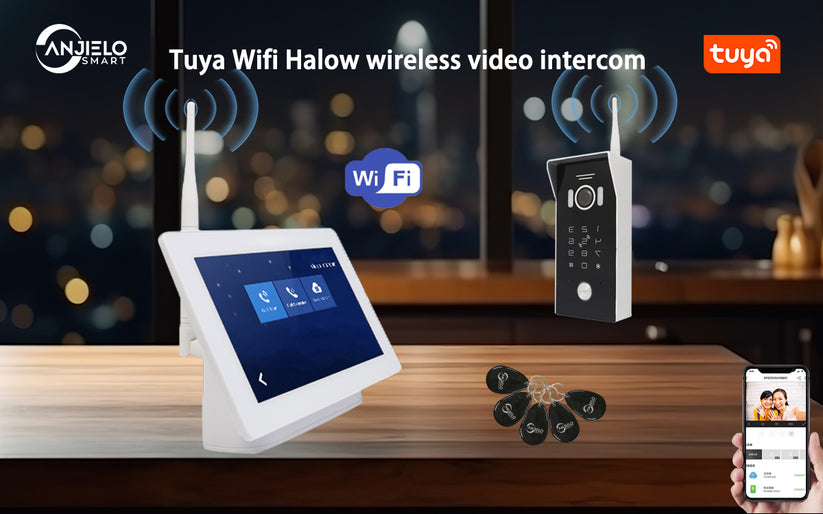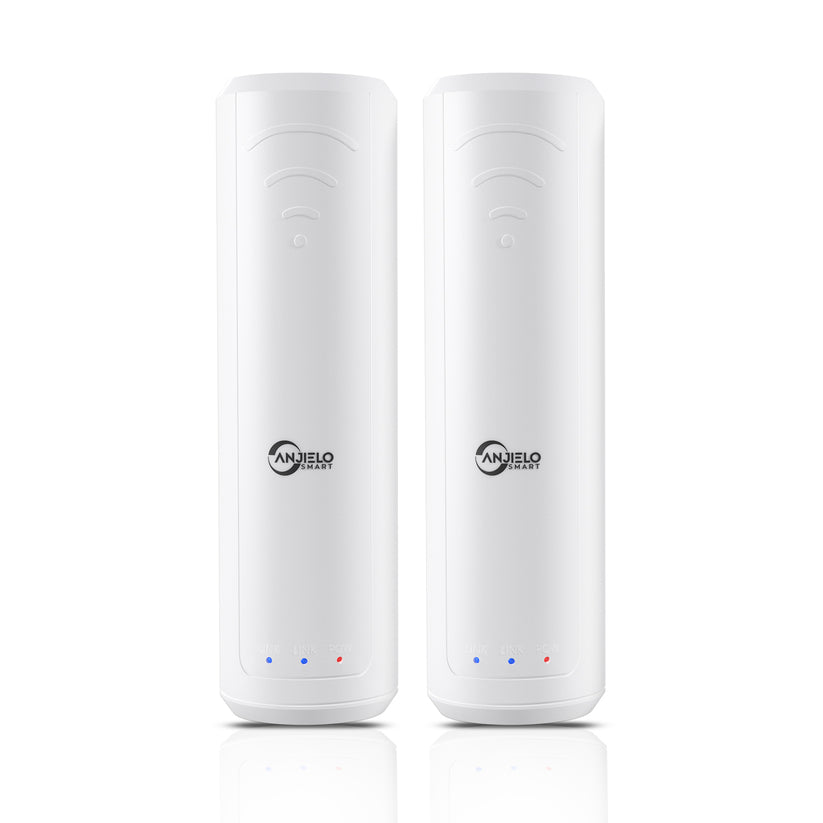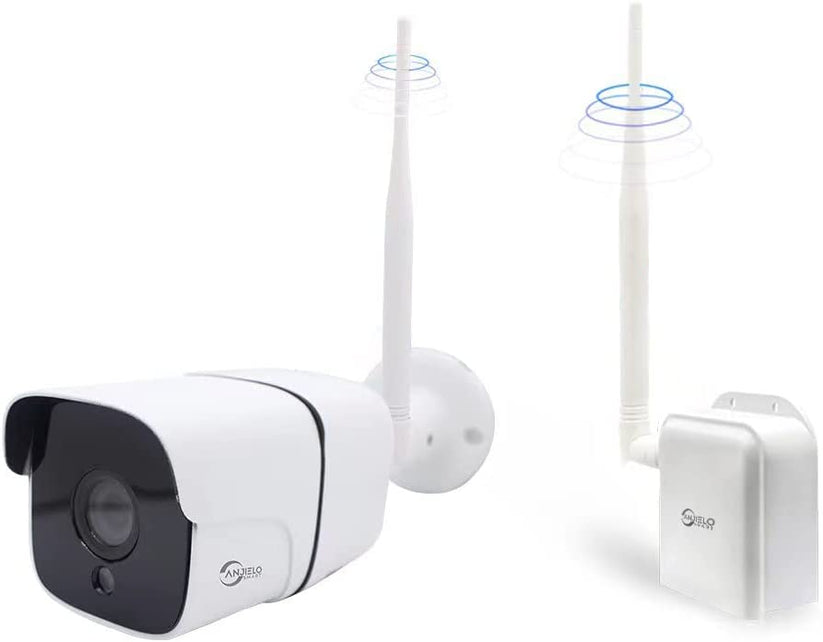
How is Wi-Fi HaLow different from traditional Wi-Fi?
Share
ANJIELOSMART Wi-Fi HaLow is essentially a low-power, long-range, versatile version of Wi-Fi that operates on the license-free 1 gigahertz spectrum. The Wi-Fi HaLow standard combines energy efficiency, long-range connectivity, low latency, HD video quality data rates, security features and native IP support, making it the ideal protocol choice for wirelessly connected, battery-powered IoT devices. Let’s look at some of the key differences between Wi-Fi HaLow and traditional Wi-Fi, and why the 802.11ah protocol is well suited to the connectivity requirements of IoT applications.
Table 1: Comparison of Wi-Fi 4/5/6 and ANJIELOSMART Wi-Fi HaLow
| Function | wi-Fi 4/5/6(IEEE 802.11n/ac/ax) | Wi-Fi HaLow(IEEE 802.1lah) |
| Operating frequency band | 2.4 GHz, 5 GHz, 6 GHz | Sub-1 GHz (902 -928 MHz in the USA) |
| Channel width selection | 20.40.80.160 MHz | 1,2,4,8,(16 optional) MHz |
| Maximum number of addressable sites per access point | 2007 | 8191 |
| Single stream MCS data rate range | 6.5 Mbps-150 Mbps(11n. Wi-Fi 4) | 150 Kbps - 86.7 Mbps |
| usual range | about 100 meters | More than 1 km 10 times farther range 100 times wider area 1000 times larger capacity (compared to 802.11n 20 MHz) |
| Link budget improvements (1 MHz channel) | - | 15-24dBm |
A power-saving protocol
ANJIELOSMART Wi-Fi HaLow provides excellent energy efficiency for power-hungry IoT devices. The various complex sleep modes specified by IEEE 802.11ah enable HaLow devices to be in an extremely low power state for a long time, saving battery energy:
Target wake time (TWT): This allows stations (STA) and access points (AP) to pre-arrange a time for sleeping stations to wake up and listen for beacons.
Restricted access window (RAW): An access point can grant permission to a subset of stations to transmit their data, while other stations are forced to sleep, buffer non-urgent data, or both.
Extended maximum Basic Service Set (BSS) idle period: This extends the site's "allowed idle period" to five years.
Hierarchical Traffic Indication Mapping (TIM): Group and encode TIM more efficiently to save beacon transmission time.
Short MAC header: This reduces header overhead, transmission time and power consumption, and frees up spectrum.
Null Data PHY Protocol Data Unit (NPD): This embeds MAC-like ACKs/NACKs into the PHY layer to reduce time and power consumption.
Short Beacons: Short (limited) beacons are sent frequently to synchronize sites, while full beacons are sent less frequently.
BSS coloring mechanism: Color assignment represents the BSS group of a specific access point, while stations can ignore other colors.
Bi-directional TXOP (BDT: Bi-directional TXOP) (formerly Speed Frame): This reduces the number of medium accesses when a station wakes up and sees the presence of uplink and downlink frames for transmission. BDT uses a response indication in the Signal (SIG) field of the Physical Layer Protocol Data Unit (PPDU) to add TXOP duration protection to third-party station transmissions.
The protocol’s efficient sleep and power management modes enable IoT devices to run on batteries for years, as well as multiple flexible power and battery size options, from coin-cell batteries for short-range IoT devices, to higher powers transmitting over a kilometer. , applications using larger batteries. Compared with Wi-Fi protocols in the 2.4 GHz and 5 GHz frequency bands, the sub-GHz narrowband signal used by this protocol has a longer transmission distance and lower energy consumption, allowing more data to be transmitted per unit of energy consumption.
As a result, ANJIELOSMART Wi-Fi HaLow chips require only a fraction of the power of traditional Wi-Fi chips. While the higher data rates of traditional Wi-Fi allow users to quickly transmit high-definition video and download large files using wideband channels in the 2.4 GHz, 5 GHz and 6 GHz bands, these Wi-Fi connections have a short range and battery Drains quickly and requires frequent recharging or battery replacement, or preferably a mains connection. For these reasons, Wi-Fi HaLow is a better choice for power-constrained IoT devices that need to reach greater distances and run on batteries for years while still delivering high data throughput.

Figure 1: Traditional Wi-Fi 4/5/6 protocols, using higher frequencies and wider bandwidth to maximize throughput.
Wi-Fi HaLow's sub-1 GHz protocol optimizes penetration, coverage, power and capacity.
Wider coverage
The 802.11 standard covers a wide range of frequencies, from sub-GHz to millimeter wave (mmWave). Wi-Fi HaLow is the first Wi-Fi standard to operate in the license-free sub-GHz frequency band. The data rates provided by Wi-Fi HaLow range from hundreds of kb/s to tens of Mb/s, and the transmission distance ranges from tens of meters to more than one kilometer.
Compared to the narrowest 20MHz channel used by traditional Wi-Fi, Wi-Fi HaLow's sub-1 GHz signal uses narrower channels, ranging from 1MHz to even narrower. This 20x bandwidth factor translates into a 13 dB link budget improvement due to lower thermal noise in the channel. Compared with traditional 2.4 GHz Wi-Fi, RF frequencies between 750 MHz and 950 MHz require an additional 8dB-9 dB of link budget to save free space transmission losses. In addition, the Wi-Fi HaLow protocol adds a range-optimized modulation and coding scheme (MCS10) that provides an additional 3dB link budget improvement.
In summary, Wi-Fi HaLow provides up to 24dB link budget improvement compared to legacy 2.4GHz IEEE 802.11n (Wi-Fi 4). Compared to the higher frequency, wider bandwidth 802.11ac (Wi-Fi 5) and 802.11ax (Wi-Fi 6/6E) protocols, Wi-Fi HaLow link budget advantages are further enhanced by using the wider 5GHz bandwidth and 6GHz spectrum. This explains why Wi-Fi HaLow signals can travel ten times farther than traditional Wi-Fi without the need for a network extender. For example, a battery-operated camera could be placed in a more convenient location on the exterior wall of a home or garage. Lighting systems can be controlled from a single AP regardless of whether the fixtures are indoors or outdoors in the garden.
Providing end users with wireless IoT solutions that cover distances of hundreds of meters without the need for additional extenders or expensive cellular data plans is a key competitive advantage of the 802.11ah protocol. The long-range coverage advantage of Wi-Fi-HaLow expands the scope of smart home and smart city networks, allowing users to control IoT devices up to 1 km away, far beyond the coverage of traditional Wi-Fi protocols.
Signal penetration is stronger
Generally speaking: the lower the frequency, the farther the coverage and the stronger the ability to penetrate obstacles. Sub-GHz Wi-Fi HaLow signals can pass through walls and other obstacles more easily than traditional Wi-Fi. Changes in building materials and layout of residential and commercial buildings have less impact on sub-GHz HaLow signals than Wi-Fi protocols in the 2.4GHz and 5GHz bands. Wi-Fi HaLow can penetrate walls and buildings, which helps reduce customer complaints and product returns that sometimes plague products that use traditional Wi-Fi.
ANJIELOSMART Wi-Fi HaLow uses orthogonal frequency division multiplexing (OFDM) modulation to correct for reflections and multipath environments. Whether a device manufacturer's product is located indoors or outdoors, or in a basement or attic, Wi-Fi HaLow ensures a robust connection between the device and the access point. This flexibility eliminates the additional cost and complexity of providing proprietary hubs or bridge devices to compensate for different home architectures.
Highly scalable solution
A single Wi-Fi HaLow access point can handle up to 8191 devices, more than 4 times that of traditional Wi-Fi access points. That's enough to connect every LED bulb, light switch, smart door lock, motorized shade, thermostat, smoke detector, solar panel, security camera, or any smart home device imaginable for the foreseeable future. A typical home Wi-Fi router usually supports dozens of devices. When deployed in the home by a broadband service provider, a single Wi-Fi HaLow access point can become a scalable platform for providing additional security and utility management devices and services.
Multiple signaling options reduce the overhead required to manage and control large numbers of HaLow devices. This minimizes signal collisions and frees up radio waves for active devices to transmit more data at the fastest modulation and coding scheme (MCS) rates. Like traditional Wi-Fi, HaLow automatically adjusts bandwidth based on signal integrity and distance from the access point. Predefined MCS levels support single-stream, single-antenna products with bandwidths from 150 Kbps to 40 Mbps using channel widths from 1 MHz to 8 MHz, with 80 Mbps capability also available through the use of optional 16 MHz wide channels.
Wi-Fi HaLow's star network topology, excellent penetration, wide coverage area and huge capacity liberate wireless connections from difficult-to-deploy and bandwidth-limited mesh networks, simplifying network installation and Minimize overall holding costs.

License-exempt spectrum with noise immunity
Like traditional Wi-Fi in the 2.4GHz, 5GHz and 6GHz bands, Wi-Fi HaLow enables end users to own their own devices and use license-free sub-GHz radio spectrum, ranging from 750MHz to 950MHz. The available frequency range, maximum transmission power and duty cycle of Wi-Fi HaLow vary around the world. (For example, the available HaLow spectrum in the Americas is 902 MHz to 928 MHz, while in Europe it is 863 MHz to 868 MHz).
Wi-Fi HaLow operates in the Industrial, Scientific and Medical (ISM) frequency band and can use a variety of channel bandwidths: 1MHz, 2MHz, 4MHz, 8MHz and 16MHz. The narrower the bandwidth, the farther the signal travels. Using OFDM, data is transmitted in packets across multiple sub-channels, which can improve performance in challenging RF environments, especially when there is strong interference from other radios. Forward Error Correction (FEC) encoding also provides additional protection for recovering packets, ensuring a robust connection.

Security and interoperability
Like other IEEE 802.11 Wi-Fi versions, Wi-Fi HaLow is an inherently secure wireless protocol that supports the latest Wi-Fi certification requirements (WPA3) and over-the-air (OTA) AES encryption at data rates that enable secure OTA firmware upgrade.
Like other types of Wi-Fi, HaLow is a globally recognized standard (IEEE 802.11ah) that defines how connected devices authenticate and communicate securely. Equipment vendors that adopt Wi-Fi HaLow can guarantee that their products and networks will achieve interoperability in accordance with the Wi-Fi Alliance's development guidance. Since Wi-Fi HaLow is part of the IEEE 802.11 standard, Wi-Fi HaLow networks can also coexist with Wi-Fi 4, Wi-Fi 5 and Wi-Fi 6 networks without affecting their RF performance.
Implement local IP support
All IoT networks require Internet Protocol (IP) support to enable cloud connectivity. Since Wi-Fi HaLow is an 802.11 Wi-Fi standard, it provides native TCP/IP support. This built-in IP capability means that IoT connectivity does not require proprietary gateways or bridges. All client devices connected to a Wi-Fi HaLow-enabled router can directly access the Internet using the IPv4/IPv6 transport protocol for cloud-based services and management of IoT data.
The HaLow Effect: Extending the Range and Expanding the Possibilities of the Internet of Things
The network congestion, range limitations and higher power consumption of traditional Wi-Fi, as well as the limited number of devices that can connect to a single AP, are no longer feasible in today's world of IoT devices. These limitations hinder the emergence of new IoT-centric business models across industries that require greater range, greater capacity, and more flexible battery and power options while minimizing deployment costs.
As a long-range protocol, Wi-Fi HaLow supports indoor and outdoor IoT applications that are beyond the reach of 2.4GHz and 5GHz Wi-Fi, such as remote security cameras, access control networks and even drones. Other potential use cases include large public venues such as stadiums, shopping malls, and conference centers, where a single Wi-Fi HaLow access point can replace a large number of access points, eliminating the need for complex mesh networks and simplifying installation. , reducing the total cost of ownership.

Numerous applications including industrial IoT, process control sensors, building automation, warehouses and retail stores will also benefit from this long-range, low-power protocol, allowing countless devices to stay connected in an increasingly automated world. In fact, Wi-Fi-HaLow stands out among traditional 802.11 protocols for its coverage, energy efficiency, capacity and versatility.




